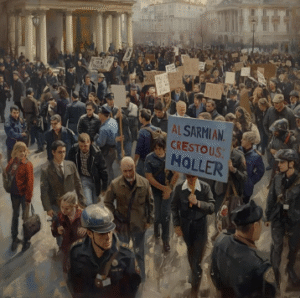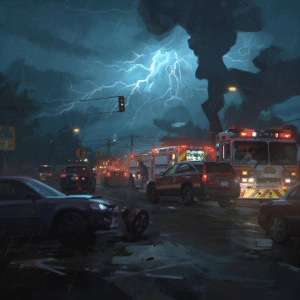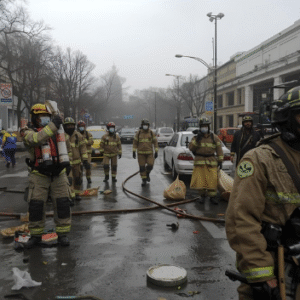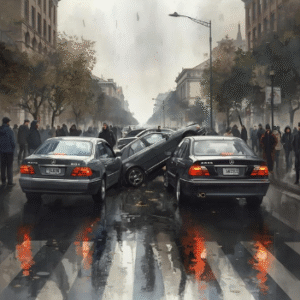Introduction to the Incident
In today’s fast-paced digital age, where millions of users scroll through their feeds daily, certain stories gain traction seemingly overnight. Recently, a significant event involving a well-known public figure took center stage on U.S. social media platforms, captivating users with its unexpected nature. The incident quickly gained attention, fueled by a combination of surprise, intrigue, and the public’s ongoing interest in the lives of prominent individuals.
What began as a seemingly isolated situation soon developed into a larger narrative, with users dissecting every available detail to uncover the full picture. The story struck a chord with online audiences, tapping into emotions ranging from shock to amusement, depending on individual perspectives. Conversations evolved rapidly, turning an isolated occurrence into a widespread topic that connected people from different communities.

One of the key reasons this particular event resonated so strongly was the relatable themes embedded within it. At its core, the story reflected issues that many people grapple with daily, albeit on a much grander scale due to the subject’s public status. This connection made it easy for individuals to join the discussion, whether to share personal insights, express opinions, or simply follow along as the details continued to emerge.
As the story unfolded, the rapid nature of online communication allowed users to access real-time updates, contributing to the sense of urgency surrounding the situation. Various platforms, from Twitter to Instagram, became battlegrounds for ideas and opinions, offering a space where individuals could both contribute to the narrative and witness it evolve. Each update brought new dimensions to the event, sparking even more engagement across these platforms.
What made this particular incident stand out was the way it highlighted the interplay between public and private life, sparking widespread curiosity about the balance between the two. This unique blend of drama, social relevance, and accessibility turned the situation into a trending topic, cementing its place as a defining moment in online culture.
Role of Social Media
The unique characteristics of social media platforms played a crucial role in transforming the incident into a national conversation. With millions of active users, platforms like Twitter, Facebook, and Instagram created an ecosystem where the story could spread rapidly and engage diverse audiences. Once initial details surfaced, the viral momentum accelerated as people shared posts, tagged friends, and added their own interpretations. This collective activity amplified the incident’s visibility and gave it the necessary traction to dominate timelines across the country.
One of the most significant factors was the ability of social media to host real-time discussions. Unlike traditional forms of communication, these platforms allowed users to interact with breaking updates immediately, enabling a constant flow of opinions and reactions. Trending hashtags further organized the discourse, making it easier for users to join in and follow the evolving conversation. The immediacy and accessibility of social media ensured that the incident didn’t remain confined to a specific demographic but resonated across age groups, professions, and regions.

Another defining aspect was the involvement of high-profile accounts. Celebrities, influencers, and public figures leveraged their platforms to weigh in on the situation, effectively broadening its reach. Their commentary often became focal points for debate, driving even more users to engage with the story. Social media personalities with large followings provided perspectives that were either informative or polarizing, fueling both interest and controversy. This added a layer of complexity to the incident, as opinions from influential voices often set the tone for wider discussions.
Visual content played an equally important role in driving engagement. Short videos, memes, and infographics quickly became tools for users to share thoughts in a way that felt relatable and creative. These forms of media added a sense of personalization to the broader narrative, making it easier for individuals to connect with or critique different aspects of the story. The interactive nature of platforms allowed users to respond with their own takes, which in turn inspired further creativity and participation.
Ultimately, the collaborative and instantaneous nature of social media transformed the event into more than just a headline. It became an ongoing dialogue, fueled by a mix of community-driven conversation and influencer contributions.
Public Reaction
The incident sparked a surge of online activity, with users expressing a range of emotions and opinions. Social media platforms became arenas for spirited debates, where individuals analyzed the situation from every angle. Discussions often focused on the broader implications, with many drawing parallels to larger societal issues. This dynamic exchange of ideas highlighted the power of digital communities to amplify diverse perspectives.
The sheer volume of content created in response was staggering. Memes and videos were shared widely, often blending humor with sharp commentary, making the incident feel accessible to different audiences. This creative output not only kept the topic relevant but also allowed users to engage with it in a way that resonated with their personal viewpoints. For some, the humor provided a coping mechanism to process the more serious undertones of the situation.

On the other hand, the incident also ignited strong divisions among users. Certain posts drew sharp lines between opposing viewpoints, with heated exchanges often breaking out in comment sections. These arguments showcased how polarizing online conversations can become, as people defended their stances with fervor. For some, this became a moment to challenge others’ opinions, while others sought to find common ground in shared experiences.
The involvement of influencers and public figures in the conversation further shaped the public’s reaction. Their posts frequently became central points of discussion, with followers either supporting or critiquing their opinions. The presence of high-profile voices often magnified the emotional intensity of the discourse, creating ripple effects that extended far beyond the immediate online communities involved.
For many, the incident served as an opportunity to reflect on personal values and societal norms. This level of engagement underscored how digital platforms provide a space for people to navigate complex topics collectively, even when opinions differ drastically. By creating a shared moment of reflection, the event encouraged a level of participation that extended beyond passive consumption, turning casual users into active contributors to a larger cultural conversation.
Media Coverage
As the incident gained momentum online, traditional media outlets took notice, dedicating significant attention to the unfolding story. Television networks, newspapers, and online news sites quickly published reports, aiming to provide context and clarity for their audiences. While social media often thrives on immediacy and emotional reactions, traditional media attempted to present a more structured and detailed account of the situation. However, the approaches taken by different outlets varied widely. Some leaned heavily into sensationalism, highlighting dramatic elements to attract viewership, while others prioritized in-depth analysis and investigative reporting.
The interplay between social and traditional media became particularly evident as news outlets incorporated user-generated content into their coverage. Screenshots of tweets, Instagram posts, and other viral content were frequently included in articles and news segments, blurring the line between original reporting and commentary on the online conversation. In some cases, media organizations even cited viral hashtags as indicators of public sentiment, underscoring how online platforms now shape the broader news cycle.

Competing agendas among outlets also influenced how the story was framed. Certain networks emphasized the entertainment value of the incident, focusing on the personal drama and reactions from prominent figures. Others shifted the narrative toward its societal implications, drawing attention to underlying issues raised by the incident. This divergence in coverage reflected the varying priorities of media organizations, as well as their target audiences.
Interestingly, traditional media’s focus on the story often mirrored the themes dominating online conversations. The demand for updates and analysis pushed outlets to prioritize this incident over other news topics, demonstrating how digital trends can dictate editorial decisions. The dynamic also showcased how traditional journalism now competes with real-time updates on social media, as reporters rushed to provide fresh angles to keep up with the online discourse.
The amplification of the incident through traditional media extended its reach to audiences who may not have been actively engaged on social platforms. This cross-platform visibility ensured that the story resonated well beyond the confines of social media, making it a pervasive topic of discussion across different demographics and mediums.
Impact on Society
The incident’s widespread reach through digital platforms sparked conversations that transcended the online realm, influencing societal attitudes and cultural awareness. Many users found themselves reflecting on broader themes connected to the event, sparking discussions about issues that resonate across various communities. This shift from individual reactions to collective dialogue demonstrated the growing influence of social media as a space for public engagement and introspection.
As the topic grew in prominence, its effects began spilling over into offline spaces. Public debates, workplace conversations, and community discussions started to mirror the narratives originally developed online. These exchanges often reflected the diversity of viewpoints seen on digital platforms, highlighting the increasingly interconnected nature of online and offline discourse. The incident acted as a catalyst, encouraging individuals to engage with topics they might otherwise overlook.

One notable outcome was the involvement of advocacy groups and organizations, many of which used the viral momentum to highlight related causes or issues. This created opportunities to raise awareness about topics often neglected in mainstream conversations. By tapping into the energy surrounding the story, these groups succeeded in broadening the scope of the dialogue, pushing it toward actionable change or at least heightened awareness.
Additionally, the incident underscored the role of public figures in shaping opinions, as many influential individuals added their voices to the discussion. Their contributions carried weight, drawing attention to specific angles of the story and amplifying its relevance. This demonstrated how highly visible individuals can steer conversations and potentially inspire collective action.
However, the situation also revealed the challenges of navigating polarized perspectives. The intensity of some discussions illuminated the deep divides present in society, where contrasting viewpoints often clashed rather than converged. While some exchanges led to productive conversations, others devolved into unproductive disagreements, emphasizing the difficulties of fostering meaningful dialogue in a highly digitalized culture.
In this case, social media’s ability to magnify both unity and division became evident, as the event brought people together in solidarity while simultaneously highlighting contentious fault lines. The story’s evolution reflected the multifaceted impact of digital platforms on modern societal dynamics, as it bridged online interactions with real-world implications.
Conclusion
The incident’s rapid rise to prominence highlights the transformative role of social media in shaping how stories evolve and gain widespread attention. By offering platforms for immediate interaction and real-time updates, these digital spaces have become integral to how people consume and engage with current events. The fast-paced nature of online conversations not only amplifies visibility but also ensures that discussions remain dynamic and multifaceted.

This particular incident underscored the capacity of social media to foster collective engagement. Users not only shared information but also actively participated in creating narratives, whether through memes, commentary, or debates. The blending of creativity with serious discourse reflects the growing influence of digital culture on public conversation. Social media’s reach allowed this story to extend beyond online circles, influencing traditional media and offline discussions alike.
One of the most striking aspects of the event was how it revealed the intersection of private lives with public scrutiny. This interplay captivated audiences, sparking dialogue about broader cultural and societal themes. The involvement of influential voices further amplified these conversations, demonstrating the power of visibility in driving attention to complex topics. However, the polarized nature of some responses also emphasized the challenges of finding consensus in highly fragmented digital environments.
As the story progressed, it became evident that social media is not just a tool for sharing information—it’s a driver of collective reflection and action. The ability to reach diverse audiences in real time, combined with the participatory nature of these platforms, allowed users to shape the trajectory of the narrative. This reflects a significant shift in how individuals influence and interact with public discourse in the digital age.
Ultimately, the incident served as a reminder of the dual-edged power of online platforms. They can inspire connection and awareness while simultaneously exposing societal divides. The story’s impact is a testament to the evolving role of social media in modern communication, offering new ways to engage with and respond to the world around us.


